Kraz, Beta Corvi (β Crv), is a yellow bright giant located in the constellation Corvus. With an apparent magnitude of 2.647, it is the second brightest star in Corvus, after Gienah. It lies at an approximate distance of 146 light years from Earth. Kraz is one of the four Corvus stars that form Spica’s Spanker, a quadrilateral asterism that points the way to Spica, the brightest star in the constellation Virgo.
Star type
Kraz is a bright giant star of the spectral type G5 II. It has a mass of 3.7 solar masses and a radius 16 times that of the Sun. The radius is derived from the angular diameter of 3.30 ± 0.17 milliarcseconds. With an effective temperature of 5,100 K, Kraz is 164 times more luminous than the Sun. The star is a slow spinner, with a projected rotational velocity of 8 km/s. Taking into account its size, it may take up to 180 days to complete a rotation. The estimated age of Beta Corvi is 260 million years.
Kraz is a variable star. Its apparent magnitude has been reported to vary from magnitude 2.66 to 2.60.
It is also listed as a weak barium star, which indicates that it may have once had a more massive companion, a carbon star on the asymptotic giant branch (AGB), and that some of the material from the companion was transferred to Kraz and polluted its surface layers when it was still on the main sequence. If there was such a companion, it would now be a dim white dwarf. No companion has been detected around Beta Corvi to date.
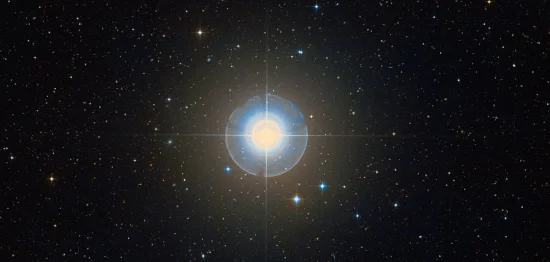
Kraz (Beta Corvi), image: Wikisky
Facts
Kraz, Algorab (Delta Corvi), Gienah (Gamma Corvi), and Minkar (Epsilon Corvi) form an asterism known as Spica’s Spanker. Located southwest of the bright Spica, the asterism represents a type of sail and can be used to find Spica. A line drawn from Gienah through Algorab leads to Virgo’s brightest star.
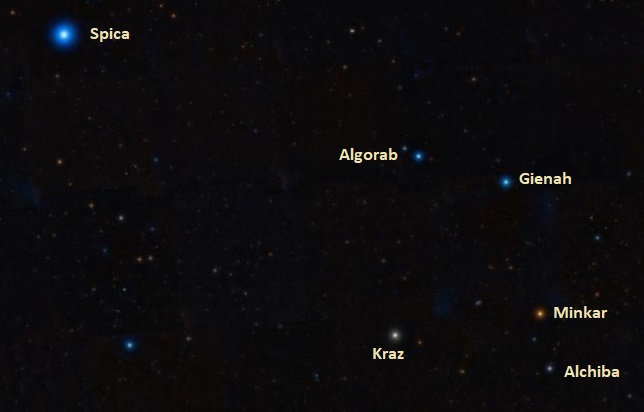
Spica’s Spanker, image: Wikisky
Name
The name Kraz (pronunciation: /ˈkræz/) comes from Czech astronomer Antonín Bečvář’s sky stlas Atlas Coeli (1951), but its origin is unknown. The name was approved by the International Astronomical Union’s (IAU) Working Group on Star Names (WGSN) on June 1, 2018.
The Chinese know Beta Corvi as 軫宿四 (Zhěn Sù sì), the Fourth Star of Chariot. In Chinese astronomy, the Chariot asterism is formed by Kraz with Gienah, Algorab and Minkar, the same stars that form Spica’s Spanker in western astronomy. Chariot is one of the southern mansions of the Vermilion Bird.
Location
Kraz is easy to find because it lies in the proximity of Spica, one of the brightest stars in the sky, and because it is part of a recognizable asterism, Spica’s Spanker. While the Spanker asterism can be used to identify Spica, its stars are considerably fainter than Virgo’s luminary and it is easier to use Spica to find them instead. Spica lies on an imaginary curved line extended from the stars of the Big Dipper’s handle—Alioth, Mizar and Alkaid – southward. Arcturus, the fourth brightest star in the sky, is the first bright star along the line and Spica is the second.
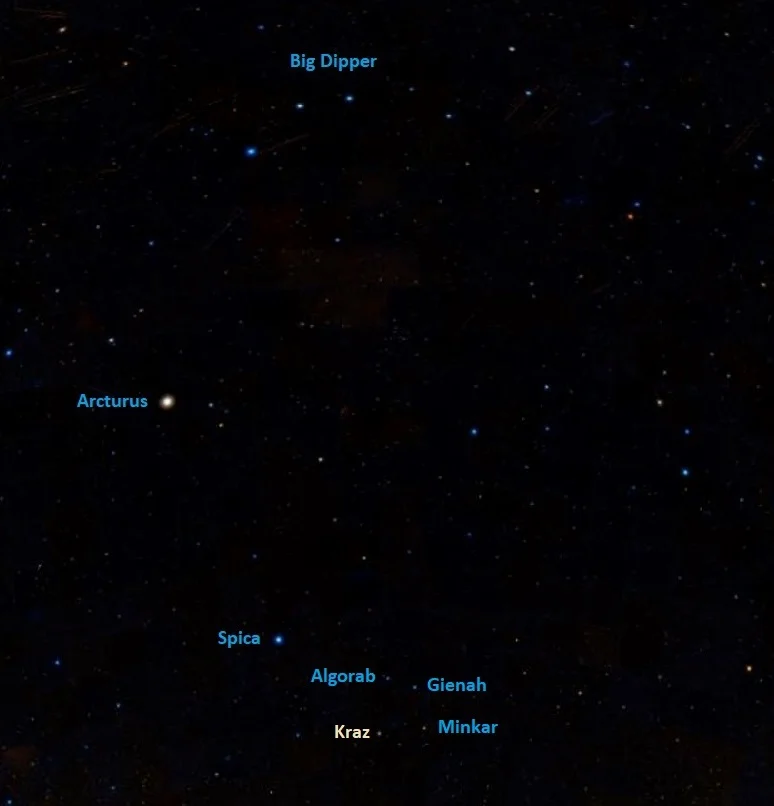
Kraz location, image: Wikisky
Spica’s Spanker is found southwest of Spica. Kraz marks the southeast (bottom left) vertex of the asterism.
Kraz can be used to find two relatively bright deep sky objects that lie in the same area of the sky. Located south of the star, in the neighbouring constellation Hydra, the globular cluster Messier 68 occupies 11’ of the sky. The cluster has an apparent magnitude of 9.67 and lies 33,600 light years away. It can be seen in binoculars but is best observed in medium-sized telescopes.
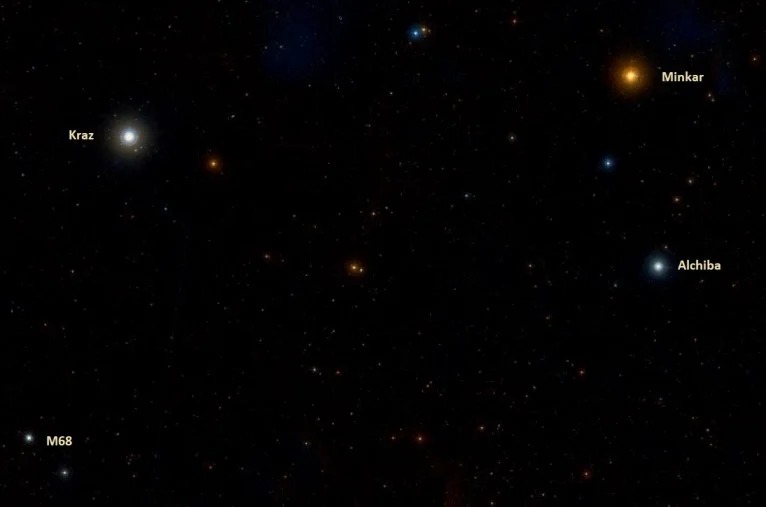
Kraz and Messier 68, image: Wikisky
The barred spiral galaxy NGC 4462 lies west of the star. It has an apparent size of 3.6 by 1.33 arcminutes and a visual magnitude of 11.54.
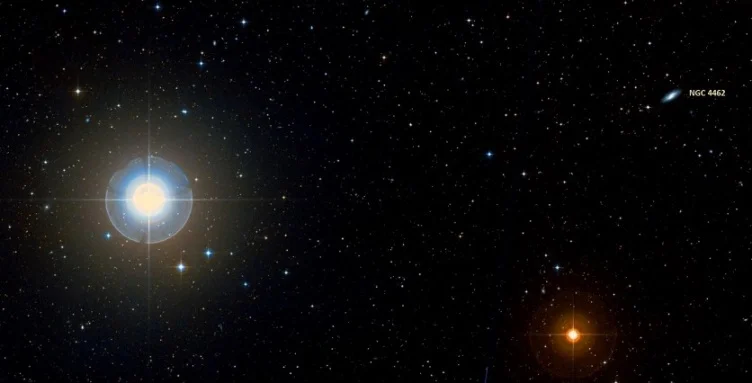
Kraz and NGC 4462, image: Wikisky
Constellation
Kraz is located in the constellation Corvus. Representing the mythical crow that the god Apollo sent to fetch him some water, Corvus is one of the Greek constellations, catalogued by Claudius Ptolemy of Alexandria in the 2nd century CE.
Corvus stretches across 184 square degrees of the southern sky and is one of the smaller constellations. It is the 70th constellation in size out of 88. It is not particularly conspicuous, with only three of its brightest stars – Gienah, Kraz and Algorab – brighter than magnitude 3.00.
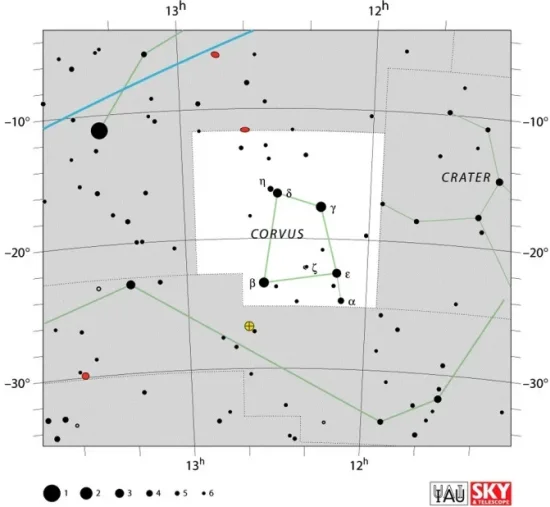
Corvus constellation map by IAU and Sky&Telescope magazine
Corvus is best-known for Spica’s Spanker, an asterism formed by its brightest stars, and for being home to the famous Antennae Galaxies (NGC 4038 and NGC 4039), an interacting pair that shows a likely future of the Milky Way and Andromeda galaxies when they begin to merge. NGC 4038 is the central galaxy in the NGC 4038 Group, which also contains NGC 4039, the barred spiral galaxy NGC 4027, the elliptical galaxy NGC 4033, the spiral galaxy NGC 3981 and type E/SB0 galaxy NGC 4024. Corvus also contains the planetary nebula NGC 4361, which occupies an area of 1.3’ by 1.3’ and has an apparent magnitude of 10.9.
Notable stars in Corvus include the blue giant Gienah, the orange giant Minkar, the double star Delta Corvi (Algorab), the class F main sequence star Eta Corvi, which has two debris disks, and the eclipsing binary systems SX Corvi and VV Corvi.
The best time of year to observe the stars and deep sky objects of Corvus is during the month of May, when the constellation climbs high above the horizon in the evening sky. The entire constellation is visible from locations between the latitudes 60° N and 90° S.
The 10 brightest stars in Corvus are Gienah (Gamma Crv, mag. 2.585), Kraz (Beta Crv, mag. 2.647), Algorab (Delta Crv, mag. 2.962), Epsilon Corvi (mag. 3.024), Alchiba (Alpha Crv, mag. 4.03), Eta Corvi (mag. 4.29 – 4.32), HD 107418 (mag. 5.14), VV Corvi (mag. 5.19 – 5-34), TY Corvi (31 Crt, mag. 5.19 – 5.23), and Zeta Corvi (mag. 5.21).
Kraz – Beta Corvi
| Spectral class | G5 II |
| U-B colour index | +0.586 |
| B-V colour index | +0.898 |
| R-I colour index | +0.44 |
| Apparent magnitude | 2.647 |
| Absolute magnitude | -0.61 |
| Distance | 146 ± 1 light years (44.7 ± 0.4 parsecs) |
| Parallax | 22.39 ± 0.18 mas |
| Radial velocity | -7.34 ± 0.08 km/s |
| Proper motion | RA: +1.11 ± 0.22 mas/yr |
| Dec.: -56.56 ± 0.12 mas/yr | |
| Mass | 3.7 ± 0.1 M☉ |
| Luminosity | 164 L☉ |
| Radius | 16 R☉ |
| Temperature | 5,100 ± 80 K |
| Metallicity | -0.01 dex |
| Age | 206 million years |
| Rotational velocity | 8 km/s |
| Surface gravity | 2.52 ± 0.03 cgs |
| Constellation | Corvus |
| Right ascension | 12h 34m 23.2348393s |
| Declination | −23° 23′ 48.337453″ |
| Names and designations | Kraz, Beta Corvi, β Crv, 9 Corvi, HD 109379, HR 4786, HIP 61359, FK5 471, SAO 180915, BD−22 3401, GC 17133, GCRV 7566, PPM 260512, CD−22 3401, CD−22 9505, CPD−22 5388, JP11 2237, IRAS 12317-2307, UBV 11287, 2MASS J12342324-2323483, PLX 2896.00, TYC 6683-1116-1, Gaia DR2 3501215730056271104 |